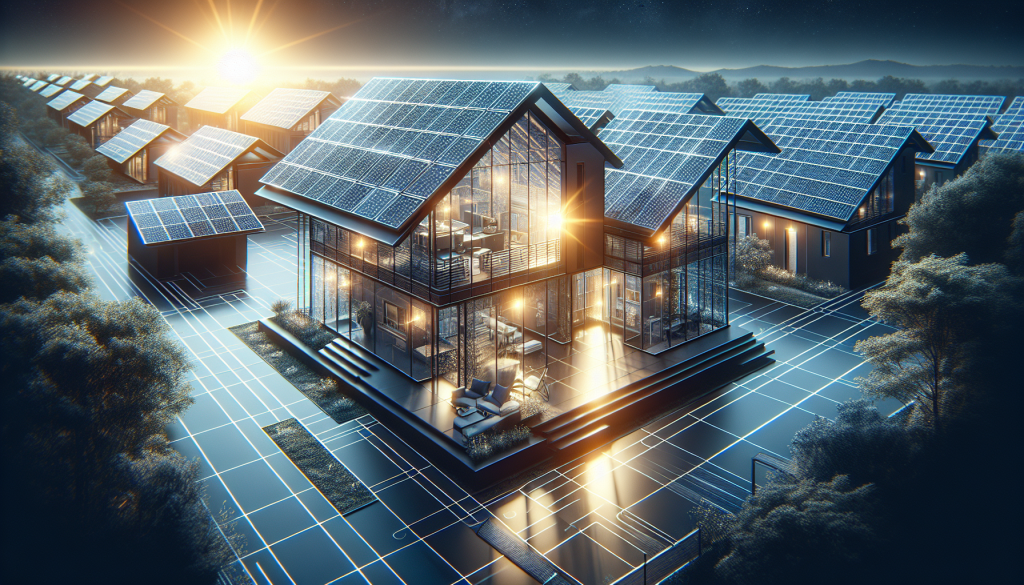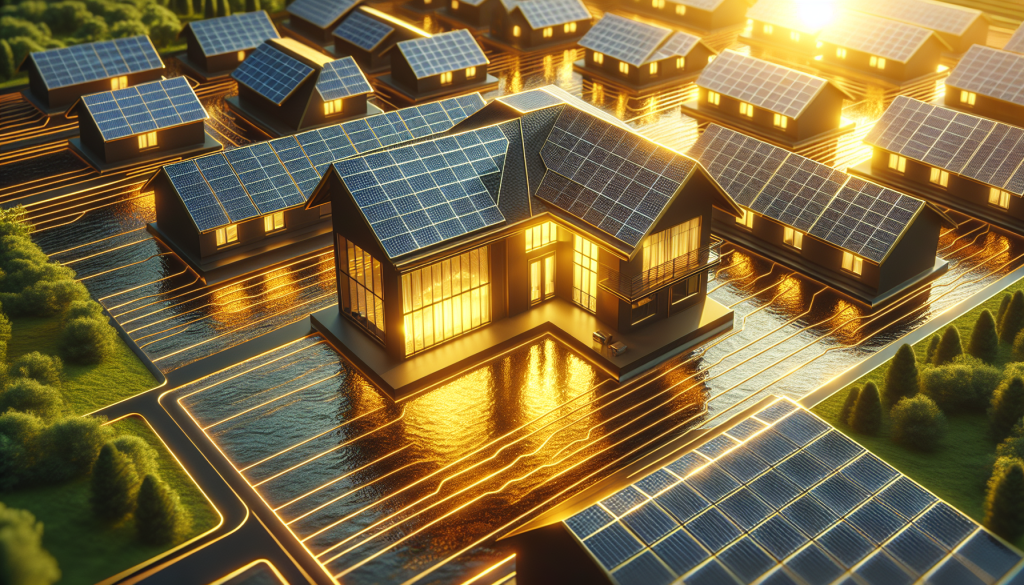How Do House Solar Panels Work
As an Amazon Associate, I earn from qualifying purchases, at no additional cost to you. Disclaimer
I recently discovered the fascinating world of house solar panels and couldn’t help but wonder: how exactly do they work? It turns out that these sleek and futuristic-looking panels are not only environmentally friendly, but also quite ingenious in their design. By harnessing the power of sunlight, these panels convert it into usable electricity that can power our homes, reducing our reliance on traditional energy sources. Let me take you on a journey to demystify the inner workings of house solar panels and uncover the science behind this innovative technology.

Understanding Solar Power
Solar power refers to the conversion of sunlight into electricity using photovoltaic cells. It is a renewable form of energy that provides numerous benefits, both for the environment and for homeowners. By harnessing the power of the sun, solar panels are able to generate clean and sustainable electricity.
What is solar power?
Solar power is the energy that is derived from the sun. It is a renewable source of energy that does not deplete natural resources or release harmful emissions. Solar power is harnessed through the use of solar panels, which contain photovoltaic cells that convert sunlight into electricity.
The significance of solar power
Solar power plays a crucial role in reducing our dependence on fossil fuels. By utilizing solar energy, we can significantly reduce greenhouse gas emissions, air pollution, and the depletion of natural resources. Additionally, solar power helps to promote energy independence and reduce electricity costs for homeowners.
Components of Solar Panels
Solar panels consist of several key components that work together to generate electricity from sunlight. These components include photovoltaic cells, a metal frame, a glass casing and film, and wiring with a fuse box connection.
Photovoltaic cells
Photovoltaic cells, also known as solar cells, are the heart of a solar panel. These cells are made of semiconductors, typically silicon, which absorb sunlight and convert it into electricity through a process called the photovoltaic effect.
Metal frame
The metal frame provides structural support and protection for the solar panel. It is made of durable materials, such as aluminum, that can withstand various weather conditions.
Glass casing and film
The glass casing and film cover the front of the solar panel and protect the photovoltaic cells from external elements. The glass is tempered to ensure durability and optimal performance.
Wiring and fuse box connection
The wiring and fuse box connection allow for the transfer of electricity generated by the solar panels to the household power system. This connection ensures that the power generated by the solar panels can be utilized to power appliances and devices in the home.

How Solar Panels Generate Energy
Solar panels generate energy through a series of processes that involve the absorption and conversion of sunlight. Understanding how solar panels work is essential in realizing the full potential of solar power.
Absorption of sunlight
Solar panels are designed to absorb sunlight, which contains photons. When sunlight hits the surface of the solar panels, the photons are absorbed by the photovoltaic cells.
Conversion of sunlight into electricity
Once the photons are absorbed by the photovoltaic cells, they excite the electrons within the cells. This creates a flow of electricity, known as direct current (DC), within the solar panels.
Role of photovoltaic cells
The photovoltaic cells are responsible for converting sunlight into electricity through the photovoltaic effect. This effect causes the excited electrons to move through the cell and generate an electric current.
Role of Inverters in Solar Panels
Inverters play a crucial role in the functioning of solar panels. They are responsible for converting the direct current (DC) electricity generated by the solar panels into alternating current (AC) electricity that can be used to power household appliances.
Conversion from DC to AC power
Inverters convert the DC electricity generated by the solar panels into AC electricity that is compatible with the household power system. This allows the electricity to be used to power appliances and devices in the home.
Types of inverters: centralized, string, and microinverters
There are several types of inverters used in solar panel systems. Centralized inverters are commonly used in large-scale solar installations and convert the electricity generated by multiple solar panels. String inverters are used in medium-sized installations and convert the electricity generated by a string of solar panels. Microinverters are used in small-scale installations and are installed on each individual solar panel.

How Solar Panels Supply Power to Your Home
Solar panels supply power to your home by connecting to the household power system and providing electricity for appliances and devices.
Connection to household power system
The electricity generated by the solar panels is fed into the household power system through the wiring and fuse box connection. This allows the solar-generated electricity to be used to power appliances and devices in the home.
Supplying power for appliances and devices
Once connected to the household power system, the electricity generated by the solar panels is used to power appliances and devices. This reduces the reliance on electricity from the grid and helps lower energy costs.
Storing extra power in the grid
In situations where the solar panels generate more electricity than the household consumes, the excess power can be stored in the grid. This allows homeowners to receive credit or compensation for the surplus electricity they contribute to the grid.
Battery Storage and Solar Panels
Battery storage is an important component in solar setups as it allows for the storage of excess solar-generated electricity for use during times when the solar panels are not producing enough energy.
Function of a battery in solar setup
Solar batteries store excess electricity generated by the solar panels for later use. During periods where the solar panels are not producing enough electricity, such as at night or during cloudy days, the stored electricity can be used to power appliances and devices.
Types of solar batteries
There are various types of batteries used in solar setups, including lead-acid, lithium-ion, and saltwater batteries. Each type has its own advantages and considerations, such as cost, lifespan, and capacity.
Importance of battery storage
Battery storage allows for greater self-sufficiency and reliability in solar panel systems. By storing excess electricity, homeowners can reduce their reliance on the grid and have a backup power source during periods of low solar generation.

Grid Connection and Solar Panels
Solar panels can be connected to the grid, allowing homeowners to benefit from net metering and the ability to draw power from the grid when needed.
Understanding net metering
Net metering is a billing system that allows homeowners with solar panels to receive credit for the excess electricity they generate and contribute to the grid. This means that when solar panels produce more electricity than is being used, homeowners can receive credits that offset their electricity costs.
Excess power to the grid
When solar panels generate more electricity than is being consumed, the excess power is fed back into the grid. This helps to offset the electricity costs and allows homeowners to contribute to the overall energy supply.
Drawing power from the grid
During periods when the solar panels are not generating enough electricity, such as at night or during cloudy days, homeowners can draw power from the grid. This ensures a continuous and reliable power supply, even when solar generation is limited.
Maintenance and Longevity of Solar Panels
Proper maintenance is essential for ensuring the longevity and optimal performance of solar panels.
Average lifespan of solar panels
Solar panels have an average lifespan of 25 to 30 years. However, with regular maintenance and proper care, they can continue to generate electricity for even longer periods.
Maintenance techniques and tips
To maintain the efficiency of solar panels, it is important to keep them clean and free from debris. Regular inspections should be conducted to ensure that all components are functioning properly. It is also essential to monitor the performance of the solar panels and address any issues promptly.
Replacement and disposal
At the end of their lifespan, solar panels can be replaced with new ones. It is important to dispose of old solar panels responsibly to minimize the environmental impact. Many manufacturers offer recycling programs for solar panels to ensure the proper handling and recycling of materials.

Financial Aspects of Solar Panels
Installing solar panels does involve an initial cost, but the long-term financial benefits can outweigh the upfront investment.
Initial cost of installation
The cost of installing solar panels can vary depending on factors such as the size of the system, the type of panels, and the complexity of the installation. However, with advancements in technology and increased adoption of solar energy, the cost of installation has become more affordable in recent years.
Potential savings with solar energy
By generating your own electricity with solar panels, homeowners can significantly reduce their monthly electricity bills. The amount of savings will depend on factors such as the size of the solar panel system and the amount of electricity consumed.
Federal credits and incentives for solar power
The government offers various incentives and tax credits to encourage the use of solar power. These incentives can help offset the initial cost of installation and make solar energy more financially appealing for homeowners.
Future Trends in Solar Energy
As technology continues to advance, solar energy is poised for further growth and innovation in the future.
Technological advancements in solar power
Advancements in solar panel technology are continuously improving the efficiency and performance of solar panels. This includes the development of new materials, more efficient manufacturing processes, and increased energy conversion rates.
Increase in solar power grid storage
The integration of battery storage systems with solar panels is expected to increase in the future. This will allow homeowners to store excess solar-generated electricity for use during peak demand periods or when solar generation is low.
Solar power use in electric vehicles
With the rise of electric vehicles (EVs), solar power can play a significant role in charging EVs through solar carports or solar charging stations. This integration of solar power and EVs can further reduce reliance on fossil fuels and promote sustainable transportation.
In conclusion, solar power is an increasingly popular and environmentally friendly way to generate electricity. Understanding the components and mechanisms of solar panels, as well as their connection to the grid and potential financial benefits, is essential for homeowners considering the switch to solar energy. With ongoing advancements in technology and increased adoption of solar power, the future of solar energy looks bright.

